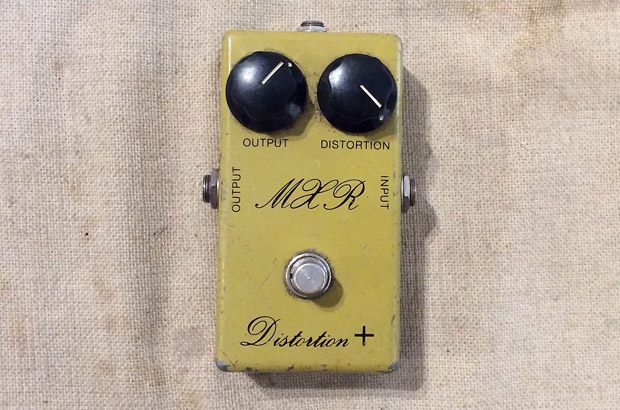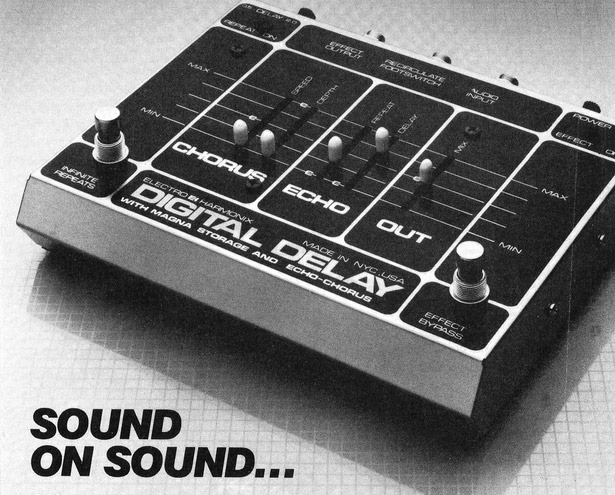This article is the fourth installment in our series on "First Effects"—which looks back to when classic and beloved effects were first created, put into the form of a pedal (or similarly portable device), and used by guitarists and other musicians. Read the rest of the series here:
As the 1970s galloped boldly toward the '80s, developments in the available tech enabled dramatically different sounds to be encapsulated in unassuming little guitar pedals.
The results were heard most notably in some extremely spacey modulation and delay effects, but metalheads would reap the benefits of hard-hitting distortion units too.
The effort to re-create the natural shimmering warble of a collection of voices or instruments singing or playing simultaneously had produced groundbreaking electro-mechanical effects almost since the dawn of amplification. Leslie's rotating speaker is the most famous such creation of the pre-transistor age (as discussed in this series' first installment), and that chorus-meets-vibrato sound was compacted down into a desktop unit in the form of the Univox (Shin-Ei) Uni-Vibe in 1968.
The transition to an actual effects pedal with footswitch as we know it today initially came, however, via a much bigger creation that incorporated chorus/vibrato circuitry as just a part of its overall capabilities.
Roland released its JC-120 and JC-60 Jazz Chorus amplifiers in 1975. In addition to their impressive clean power, the built-in chorus/vibrato effect for which they were named became an instant hit with guitarists, in addition to the keyboard players for whom they were originally intended. A year later, Roland's sister brand Boss encapsulated the circuit in pedal form as the CE-1 Chorus Ensemble, and a classic was born.
The CE-1 is bulky by today's standards, but purists will tell you that nothing else sounds quite like this unit's lush, multi-dimensional stereo chorus. Controls offer Level, Chorus Intensity, and Rate, and there's also a High/Low switch, a power switch (the CE-1 was AC powered), and footswitches for on/off and Vibrato/Chorus.
One quirk of the unit is that, like the amps that preceded it, the circuit was originally intended to receive the line-level signal of electric keyboards, so an un-buffered guitar signal straight in can result in a slightly warm, muted tone. For some, that's part of the charm; others find their way around this.
Andy Summers is invariably singled out as a notable early CE-1 user. His guitar parts on The Police's "Message in a Bottle" are dripping with that juicy Chorus Ensemble tone, and you hear the effect used throughout much of his work with that band, and elsewhere.
Soon, just about every guitarist had to have the effect under foot—more often in the form of the Boss CE-2 of 1979, a two-knob pedal in the more compact Boss casing that would soon become so familiar, or as provided by the MXR Micro-Chorus, Electro-Harmonix Small Clone, and a host of others that swamped the market.
Enabled by much the same IC-based technology that brought us the chorus pedal, and a cousin to both chorus and phaser, the flanger twists its modulation capabilities to more dramatic extremes. Yet again, the pedal was devised in an effort to reproduce an effect previously—and laboriously—made in the recording studio.
Arguably pioneered by Les Paul (as were so many things), studio flanging was produced by playing two reel-to-reel tape machines together simultaneously with the same recording on each, then alternately slowing one machine (light thumb pressure on the reel usually did the trick) to send it in- and out-of-phase with the other. This is the flanging heard on classic recordings by Pink Floyd, the Small Faces, Eric Burdon & the Animals, Jimi Hendrix, John Lennon, and later The Doobie Brothers, Hawkwind, the Eagles, and others.
As re-created in pedal form, the key to the effect's function lies in its ability to split and harmonically tune the out-of-phase notches and, relative to these, the peaks within the signal. The combination creates a lush harmonic spacing between the two according to the speed of the unit's sweep and its depth or intensity. Used subtly, flanging can sound a little like a medium-depth chorus or phaser pedal. Used heavily and relentlessly, it gets more into the seasick-acid-trip realm.
The A/DA Flanger of 1977 put this circuit in a rugged enclosure with stomp-switch and five control knobs, and is the undisputed king of flanging, but it wasn't the first on the market.
Legendary effects designer David Cockerell devised the Electric Mistress circuit, released by Electro-Harmonix in '76, and most accounts indicate that the Ibanez FL-305 and Tychobrahe Pedalflanger hit the market the same year. The year after, MXR and Mutron got into the game alongside A/DA.
Significant pedal-based flanger recordings are heard in Billy Duffy's infectious guitar riff on The Cult's "She Sells Sanctuary," Robert Smith's guitars on The Cure's "Just Like Heaven" and "A Forest," Edward Van Halen's monstrous riffs on "Ain't Talkin' 'Bout Love," and elsewhere.
The literal concept of signal distortion had obviously been in use for years, ever since the first guitarist turned an amp up past the point of clipping or abused (or simply broke) some other piece of gear that emitted a distorted sound as a result. As with so much else in the '70s, though, guitarists were chasing methods of producing that fat, gnarly, rock-certified sound without cranking up 100-watt stacks to foundation-rumbling decibel levels. The distortion pedal was one method by which it was delivered.

The distortion pedal was clearly kin to the fuzz and overdrive, but—while the three can merge in some ways at the extreme settings of one or the other—it's really quite different from either. The general intention of the distortion, as opposed to the fuzz's distinctively transistorized clipping and the overdrive's faux-tube-amp clipping, is to approximate a guitar amp that's being slammed, rather than just gently pushed. As such, it uses much of the same transistor, diode, or IC technology to get there, but the distortion just drives it all a little harder.
MXR's Distortion+ of 1973 might lay claim to being one of the earliest examples of the breed, but by today's standards it's really closer to a medium-gain overdrive pedal than a true distortion.
The Boss DS-1 Distortion pedal of 1978 might, therefore, lay claim to "seminal distortion," and its sharp, edgy, cutting tone certainly delivers what we expect from this breed of breakup as opposed to softer, rounder overdrive. Shred supremos Steve Vai and Joe Satriani both used DS-1s early on, and the iconic Boss monster also helped kickstart the grunge phenomenon under the feet of Nirvana's Kurt Cobain.
Another abiding classic is ProCo's RAT pedal of 1979. Founded in 1970, the Kalamazoo, Michigan company had specialized in cables, DIs, and other atonal devices until the guitar world demanded a better distortion in the late '70s, and ProCo delivered. Running from smooth, subtle degrees of clipping that might be categorized as overdrive, to edgy, jagged distortion, RAT pedals (or, later, Turbo RATs) have been used by Dave Grohl of the Foo Fighters, Graham Coxon of Blur, Jeff Beck, and at least two of the three Radiohead guitarists, among—oh—about a zillion others.
By the mid-'80s, every pedal maker worth its salt had a distortion on the market. Notables include DOD's FX55, out in '83, Ibanez's DS10 Distortion and Super Metal pedals, and Boss's DF-2 Super Feedbacker & Distortion.
We'd had analog delay pedals for several years already by the time the first digital delay arrived in the early '80s, but this new technology—touted as the be-all and end-all of everything signal-processing—enabled previously unheard-of delay lengths, higher fidelity, and unprecedented parameter controls. It really did mark a great leap forward for echo in the process.

Today, guitarists who don't need particularly long delay times or more than the basic controls will often prefer the supposedly warm, slightly grainy sound of analog delay (with some digital delays having earned a reputation for being a little "cold" or "sterile"), but it's impossible to deny the "wow" factor that the early units brought to the table. In fairness, clever designers have devised plenty of digital units over recent years that can rival the best analog classics for warmth and richness of tone.
Larger and more complex rack-unit digital delays had existed for a couple years when Electro-Harmonix released its two-second Digital Delay (with Magna Storage and Echo Chorus, to give it its full name) in 1981. With sliders rather than traditional rotary knobs for the Echo Delay and Repeat, Chorus Depth and Speed, and overall output level, plus slider switches for effects selection and two footswitches for Bypass and Infinite Repeats, the unit was a formidable beast. The so-called Magna Storage also offered an unprecedented live-performance feature, too, in what was actually a sample/repeat loop capability.
Two years later EHX's David Cockerell expanded digital capabilities exponentially in the legendary 16 Second Digital Delay. The real bragging point about this was, of course, its significantly more powerful looping capabilities… because, who really wants a note to echo back 16 seconds later in standard delay mode anyway?
Boss scored what might have been the most popular digital delay of the era, though, with the DD-2 Digital Delay pedal of 1983. Housed in the traditional Boss enclosure, the DD-2 carried controls for E(ffect) Level, F(eed) Back, and D(elay) Time, in addition to a Mode switch that enabled delay times of 50ms, 200ms, or 800ms, and Hold. Notable users of the DD-2 or the DD-3 that followed it include Slash, Nuno Bettencourt, and Joe Walsh, but there are scads of others who added it to their pedalboards throughout the '80s.
Also noteworthy in the mid-'80s were the PDS 1000 and PDS 1002 from DOD's DigiTech arm, with one and two-second maximum delay/sample capabilities, respectively, and these were a big hit with players seeking to add short loops to their playing repertoires in addition to the basic (and long) echoes onboard.
Find the rest of the series below. Excited to learn more about the past, present, and future of effects? Get ready for The Pedal Movie, Reverb's first feature-length documentary, arriving early 2021. Click here to keep up-to-date with the movie's release.
- Part 1: Tremolo, Echo, and Other Early Electro-Mechanical Effects
- Part 2: Fuzz, Wah, and Other Transistor-Based Effects
- Part 3: Phase Shifters, Compressors, and Other Effects from the Early '70s
- Part 4: Rise of Modulation: Chorus, Flangers, and Delay


